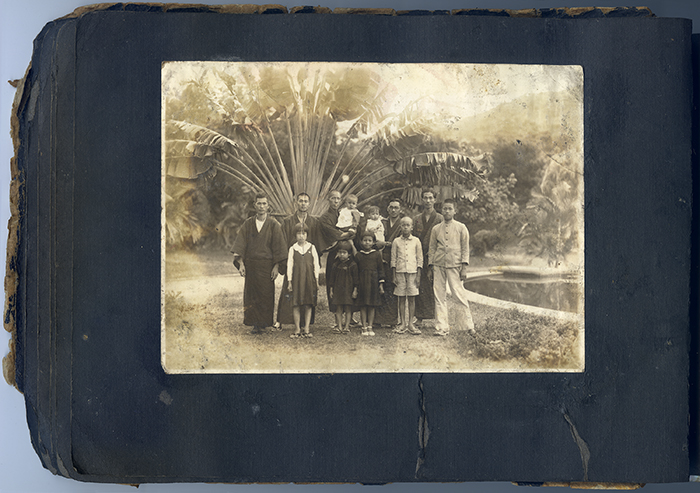ARTHUR OU
OBSERVER EFFECT
In photographs of my grandfather’s childhood, signs of Taiwan’s colonial past are everywhere. One that has stayed acutely imprinted in my mind is a group portrait of my youthful grandfather and relatives taken in the 1920’s. I remember the traditional yukatas worn by the men and the Japanese style school uniforms worn by the children, their stiff countenance and stance probably due to the prolonged exposure needed to make the picture. But what was striking were the unusually large leaves of a banana tree sprouting behind the assembled group. Its leaves were black and oily, each leaf disproportionately larger than the heads of the adults. If the tree had tentacles, it would be not unlike a type of carnivorous plant, engulfing the posing subjects standing within its grasp. Capturing the apparent incongruity of the elements in this photograph—my grandfather and relatives, the tropical climate of Taiwan, the Japanese clothing—was undoubtedly not the intention of the photographer, but the image stands as a compositional view of the contrasting forces shaping life in Taiwan at the time.

The act of seeing is never passive. The idea of the observer effect goes something like this: When one casts their gaze onto something, the observer changes or has influence over the future path of the subject or object’s being, however minutely. Seeing entangles the observer to the observed. Seeing requires the presence of light. So the mere presence of light and the observed object subjected to reflecting the light already causes a shift in its state on a subatomic level, since an electron changes course when it comes into contact with a photon. The photographic act is perhaps even more consequential to the subject depicted. There are countless numbers of examples supporting this proposition, from photography’s role in influencing behavior, shifting public opinion, changing the course of conflicts, and shaping history. In the photograph of my grandfather, did they decide themselves to dress in traditional Japanese clothing? Or did the photographer ask them to?
It is common knowledge that the etymology of the word “photography” is rooted in Greek; “fotografía” translates to “drawing with light.” It is also accepted understanding that a photograph, although indexical, is more of a subjective transcription rather than an objective, evidentiary document. We can broaden this notion of photography’s role in shaping reality through other cultural understandings of the medium. In Japanese, “photography” is translated to “写真” which are the characters for “writing reality,” while in Chinese, the characters “攝影” means “recording shadows.” A photographic observation is an intervention and changes the course of the subject’s future path. This photograph of my grandfather is part of his identity, putting the colonial forces shaping his life on display. And in turn, these forces, represented through this single photograph, have since been weaved into the fabric of my worldview.
—
Arthur Ou was born in 1974 in Taipei (Taiwan) and is based in Queens, New York. He has exhibited internationally, most recently in the 2018 Queens International at the Queens Museum, “99¢” at the Museum of Contemporary Art, Detroit, and “Astoria” at the Grazer Kunstverein in Graz, Austria. His work has been featured in publications including Artforum, Aperture, Blind Spot, Camera Austria, and Art in America. His work has also been considered in published surveys “THE PHOTOGRAPH AS CONTEMPORARY ART,” by Charlotte Cotton, “THE BEAUTY OF A SOCIAL PROBLEM: PHOTOGRAPHY, AUTONOMY, ECONOMY,” by Walter Benn Michaels, and “PHOTOGRAPHY IS MAGIC,” also by Charlotte Cotton. His book, “THE WORLD IS ALL THAT IS THE CASE,” was published by Roma publications in 2019. He is an associate professor of photography at Parsons School of Design in New York City.
